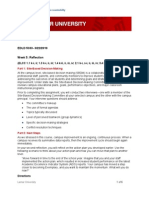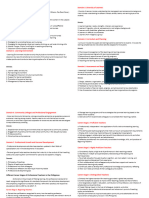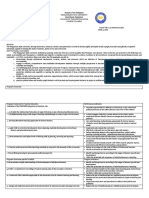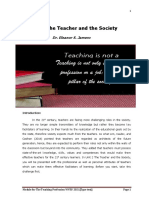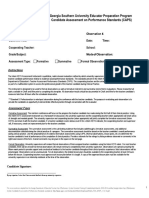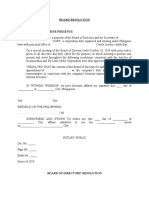Course Sem/Ay Prepared by Prepared For Date: Laguna State Polytechnic University
Course Sem/Ay Prepared by Prepared For Date: Laguna State Polytechnic University
Uploaded by
Arolf John Michael LimboCopyright:
Available Formats
Course Sem/Ay Prepared by Prepared For Date: Laguna State Polytechnic University
Course Sem/Ay Prepared by Prepared For Date: Laguna State Polytechnic University
Uploaded by
Arolf John Michael LimboOriginal Title
Copyright
Available Formats
Share this document
Did you find this document useful?
Is this content inappropriate?
Copyright:
Available Formats
Course Sem/Ay Prepared by Prepared For Date: Laguna State Polytechnic University
Course Sem/Ay Prepared by Prepared For Date: Laguna State Polytechnic University
Uploaded by
Arolf John Michael LimboCopyright:
Available Formats
Republic of the Philippines
Laguna State Polytechnic University
Province of Laguna
College of Teacher Education
Bachelor of Physical Education
COURSE THE TEACHING PROFESSION
SEM/AY FIRST SEMESTER/2020-2021
PREPARED BY FRANCHESCA MAE M. FRANCISCO
PREPARED FOR MRS. DAISY ARANGUREN
DATE FEBRUARY 6, 2021
MODULE 6
ENGAGING ACTIVITIES: CRITICAL QUESTIONS
1. How can the standards for professional teachers improve the quality of teachers in the
Philippines?
The Philippine Professional Standards for Teachers, which is built on National
Competency – Based Teacher Standard, complements the reform initiatives on teacher
quality from pre-service education to in-service training. It articulates what constitutes
teacher quality in the K to 12 Reform through well-defined domains, strands, and
indicators that provide measures of professional learning, competent practice, and
effective engagement. This set of standards makes explicit what teachers should know, be
able to do and value to achieve competence, improved student learning outcomes, and
eventually quality education. It is founded on teaching philosophies of learner-
centeredness, lifelong learning, and inclusivity/inclusiveness, among others. The
professional standards, therefore, become a public statement of professional
accountability that can help teachers reflect on and assess their own practices as they
aspire for personal growth and professional development.
2. As education student, how can you prepare yourself for these professional standards for
teachers?
The Philippine Professional Standards for Teachers defines teacher quality in the
Philippines. The standards describe the expectations of teachers’ increasing levels of
knowledge, practice, and professional engagement. At the same time, the standards allow
for teachers’ growing understanding, applied with increasing sophistication across a
broader and more complex range of teaching/learning situations. I can prepare myself as
an education by:
Bachelor of Physical Education S.Y. 2020-2021
First Semester
Republic of the Philippines
Laguna State Polytechnic University
Province of Laguna
Recognizing the importance of mastery of content knowledge and its
interconnectedness within and across curriculum areas, coupled with a sound and
critical understanding of the application of theories and principles of teaching and
learning.
Providing learning environments that are safe, secure, fair and supportive in order
to promote learner responsibility and achievement.
Establishing learning environments that are responsive to learner diversity.
Interacting with the national and local curriculum requirements.
Applying a variety of assessment tools and strategies in monitoring, evaluating,
documenting and reporting learners’ needs, progress and achievement.
Establishing school-community partnerships aimed at enriching the learning
environment, as well as the community’s engagement in the educative process.
Valuing personal growth and professional development and exhibit high personal
regard for the profession by maintaining qualities that uphold the dignity of
teaching such as caring attitude, respect, and integrity.
Bachelor of Physical Education S.Y. 2020-2021
First Semester
Republic of the Philippines
Laguna State Polytechnic University
Province of Laguna
PERFORMANCE TASK: TEACHERS’ COMPETENCIES FOUND IN THE NCBTS & PPST
Instructions: Study and analyze the following competencies of the teachers. Write, opposite
the item in each row, the domain, and the strands where each competency matches.
Competencies Domain Strands
1. Careful about the effect Domain 2: Learning Environment Establish and maintains
of one’s behavior on consistent standards of
students. learners’ behavior.
2. Encourages learners to Domain 2: Learning Environment Creates an environment that
ask question. promotes fairness.
3. Handles behavior Domain 2: Learning Environment Establish and maintains
problems quickly and consistent standards of
with due respect to learners’ behavior.
children’s rights.
4. Design and utilizes Domain 4: Curriculum Selects teaching methods,
teaching methods that learning activities, and
consider the learning instructional materials or
process. resources appropriate to
learners and aligned to the
objectives of the lesson.
5. Delivers accurate and Domain 5: Planning, Assessing and Develops and uses a variety
updated content Reporting of appropriate assessment
knowledge using strategies to monitor and
appropriate evaluate learning.
methodologies,
appropriate
methodologies
approach and
strategies.
6. Adopts strategies to Domain 3: Diversity of Learners Demonstrates concern for
address needs of holistic development of
differently abled learners.
student.
7. Improves teaching Domain 5: Planning, Assessing and Monitors regularly and
performance based on Reporting provides feedback on
feedback from learners’ understanding of
students, peer and content.
superiors and
cooperating teachers.
8. Manifests personal Domain 1: Social Regard for Acts as a positive role
qualities such as Learning model for students.
Bachelor of Physical Education S.Y. 2020-2021
First Semester
Republic of the Philippines
Laguna State Polytechnic University
Province of Laguna
enthusiasm, flexibility
and caring.
9. Involves community in Domain 6: Community Linkages Establishes a learning
sharing accountability environment that responds
for the learner’s to the aspirations of the
achievement. community.
10. Provides activities and Domain 7: Personal Growth and Reflects on the extent of the
uses materials which fit Professional Development attainment of learning goals.
the learner’s learning
styles, goals and
culture.
Bachelor of Physical Education S.Y. 2020-2021
First Semester
You might also like
- LP Grade 1 Ebglish COT 3rdDocument6 pagesLP Grade 1 Ebglish COT 3rdMa Lourdes Eduvane To-ong100% (24)
- IPCC AR6 WGIII PressConferenceSlides PDFDocument28 pagesIPCC AR6 WGIII PressConferenceSlides PDFConstanza Canales SaavedraNo ratings yet
- Field Study 2 Participation and Teaching AssistantshipDocument214 pagesField Study 2 Participation and Teaching AssistantshipAidie Mendoza100% (3)
- REVISED Module in Prof Educ 103 2020Document78 pagesREVISED Module in Prof Educ 103 2020hpnadong100% (1)
- EDLD 5333 Week 5 AssignmentDocument6 pagesEDLD 5333 Week 5 Assignmentmiguel_leija00No ratings yet
- NAtional CompetencyDocument1 pageNAtional CompetencyEzekiel D. Rodriguez75% (4)
- FTC 4 Final ReviewerDocument16 pagesFTC 4 Final ReviewerPaulo DantesNo ratings yet
- Planning For Continuing Professional Development and Lac PlanningDocument9 pagesPlanning For Continuing Professional Development and Lac PlanningMARIA CHRISTINANo ratings yet
- 7 Domains of Teaching ExcellenceDocument4 pages7 Domains of Teaching ExcellenceCharlyn AbarratigueNo ratings yet
- Module 2-Lyka Marasigan (2a3)Document23 pagesModule 2-Lyka Marasigan (2a3)Jane Bermoy100% (1)
- SynthesisDocument4 pagesSynthesisRom RamNo ratings yet
- Chapter 2 Answer SheetDocument3 pagesChapter 2 Answer SheetsharjaNo ratings yet
- Technology For Teaching and Learning 1Document16 pagesTechnology For Teaching and Learning 1Ma. Kristel OrbocNo ratings yet
- Fil 102 - Pagbasa - SyllabusDocument8 pagesFil 102 - Pagbasa - SyllabusKim Per100% (1)
- FL - Masining Na Pagpapahayag PDFDocument13 pagesFL - Masining Na Pagpapahayag PDFMa. Kristel OrbocNo ratings yet
- Pangasinan State University College of Teacher Education Course SyllabusDocument7 pagesPangasinan State University College of Teacher Education Course SyllabusLYCA DELA CRUZNo ratings yet
- EL 100 Msjbfinal OBE Intro. To LinguisticsDocument9 pagesEL 100 Msjbfinal OBE Intro. To LinguisticsJovilleNo ratings yet
- Tabano, Darmo - MATATAG-WAP-Template-2 - For-Teachers 1-3 - SessionNo15Document6 pagesTabano, Darmo - MATATAG-WAP-Template-2 - For-Teachers 1-3 - SessionNo15Irene DulayNo ratings yet
- Genovia Mid-Year Review Form For T1-T3Document4 pagesGenovia Mid-Year Review Form For T1-T3Elizabeth GenoviaNo ratings yet
- 4.-LMD2 - Module4 Template LND MAPEH NEWDocument10 pages4.-LMD2 - Module4 Template LND MAPEH NEWmeriam.nool002No ratings yet
- STUDENT CENTEREDcompDocument29 pagesSTUDENT CENTEREDcompRaymund P. CruzNo ratings yet
- Sept. 28 - Professional Standards in The PhilippinesDocument5 pagesSept. 28 - Professional Standards in The PhilippinesRyan DumaualNo ratings yet
- FL - Introduksiyon Sa Wikang FilipinoDocument19 pagesFL - Introduksiyon Sa Wikang FilipinoMa. Kristel OrbocNo ratings yet
- Activity 5 - The Teaching ProfessionDocument3 pagesActivity 5 - The Teaching ProfessionShamalyn M. SendadNo ratings yet
- FL - Panimulang LinggwistikaDocument22 pagesFL - Panimulang LinggwistikaMa. Kristel OrbocNo ratings yet
- CALMA - MATATAG WAP English 4Document8 pagesCALMA - MATATAG WAP English 4tggNo ratings yet
- FL - Technology For Teaching and Learning 1Document16 pagesFL - Technology For Teaching and Learning 1Ma. Kristel Orboc100% (1)
- Course Syllabus For Flexible Learning: Lapu-Lapu City CollegeDocument22 pagesCourse Syllabus For Flexible Learning: Lapu-Lapu City CollegeMa. Kristel Orboc100% (1)
- FL - Kulturang PopularDocument21 pagesFL - Kulturang PopularMa. Kristel OrbocNo ratings yet
- Syllabus Understanding The SelfDocument11 pagesSyllabus Understanding The SelfAngge Cordova100% (1)
- Child and Adolescent DevelopmentDocument8 pagesChild and Adolescent DevelopmentPSD Cha - RAC LucbanNo ratings yet
- Btled Ict 1 2020 Iso Obe Syllabus2Document6 pagesBtled Ict 1 2020 Iso Obe Syllabus2Angelica Perez NimesNo ratings yet
- Pangasinan State University COLLEGE OFDocument10 pagesPangasinan State University COLLEGE OFAyessa Joy GarciaNo ratings yet
- Module 2 Learning Tasks EDUTC04Document8 pagesModule 2 Learning Tasks EDUTC04Lenard Jay VilliarosNo ratings yet
- ED 201 Module (Unit 2)Document18 pagesED 201 Module (Unit 2)Lowela Joy AndarzaNo ratings yet
- Chapter II The Teacher in The Classroom and CommunityDocument36 pagesChapter II The Teacher in The Classroom and CommunityLes SircNo ratings yet
- Pe 1 SyllabusDocument10 pagesPe 1 SyllabusMichael Thom Cacho Nanat50% (4)
- Chapter 2 The Demands of Society From The Teachers As A Professional and As A PersonDocument8 pagesChapter 2 The Demands of Society From The Teachers As A Professional and As A PersonBergantin Ma. Belen C.100% (1)
- Activity-7 - Ligutan Lalaine ADocument2 pagesActivity-7 - Ligutan Lalaine ALalaine LigutanNo ratings yet
- Bulacan State University: Hagonoy Campus Teacher Education Program Iba - Carillo, Hagonoy, BulacanDocument12 pagesBulacan State University: Hagonoy Campus Teacher Education Program Iba - Carillo, Hagonoy, BulacanGwyn CalanocNo ratings yet
- The Demands of Society From The Teacher As Professional 1Document8 pagesThe Demands of Society From The Teacher As Professional 1Dianne GomeraNo ratings yet
- Syllabus in Edukasyong Pantahanan at Pangkabuhayan 2Document19 pagesSyllabus in Edukasyong Pantahanan at Pangkabuhayan 2RedMoonLight100% (2)
- INSET FORM-R.1-Professional-Development-Program-Application-FormDocument24 pagesINSET FORM-R.1-Professional-Development-Program-Application-FormShellaine Columbres Delgado-PolliscoNo ratings yet
- JOHN LUAY - Final - MATATAG-WAP - May2024Document6 pagesJOHN LUAY - Final - MATATAG-WAP - May2024John B. LuayNo ratings yet
- Syllabus 2S-Math12Document9 pagesSyllabus 2S-Math12pontiveros.fcNo ratings yet
- PED 1102 Module 2.editedDocument15 pagesPED 1102 Module 2.editedกาวี กบาลสักNo ratings yet
- Intern Keys Observation Form With Indicators & Evaluation PDFDocument5 pagesIntern Keys Observation Form With Indicators & Evaluation PDFjenNo ratings yet
- Module 13-Competency Framework - Johanna Realon (Beed II-A)Document22 pagesModule 13-Competency Framework - Johanna Realon (Beed II-A)Johanna Realon100% (1)
- 111 FILIPINO Learning EnvironmentsDocument11 pages111 FILIPINO Learning Environmentsmarkflugencio112719No ratings yet
- Social Dimensions and The Teaching Profession 2Document20 pagesSocial Dimensions and The Teaching Profession 2Winona AtayanNo ratings yet
- FS1 Unit 1Document42 pagesFS1 Unit 1Arnold C. LasitNo ratings yet
- The Philippine Professional Standards For TeachersDocument4 pagesThe Philippine Professional Standards For TeachersKairmela PeriaNo ratings yet
- FIL 118 Pagtuturo at Pagtataya Sa Panitikan SyllabusDocument8 pagesFIL 118 Pagtuturo at Pagtataya Sa Panitikan SyllabusJovito Limot100% (3)
- Rpms Portfolio (Deped Design)Document22 pagesRpms Portfolio (Deped Design)Jolar Marc GuevarraNo ratings yet
- INSET Proposal 2024Document8 pagesINSET Proposal 2024Joan NavarreteNo ratings yet
- Individual Development Plan 2020 2021Document4 pagesIndividual Development Plan 2020 2021jhullian diaz67% (3)
- Joyce Ann S. Dimaguila - Matatag - WapDocument7 pagesJoyce Ann S. Dimaguila - Matatag - WapJam Dimaguila100% (1)
- Philippine Professional Standards For Teachers (PPST) August 11, 2017 Deped Order No. 42, S. 2017Document3 pagesPhilippine Professional Standards For Teachers (PPST) August 11, 2017 Deped Order No. 42, S. 2017GSCNo ratings yet
- Annual Performance Development Plan For TeachersDocument3 pagesAnnual Performance Development Plan For Teachersapi-367359881100% (1)
- SLRP 2024Document14 pagesSLRP 2024Eljohn Coronado Timbangan100% (1)
- The Structured Method of Pedagogy: Effective Teaching in the Era of the New Mission for Public Education in the United StatesFrom EverandThe Structured Method of Pedagogy: Effective Teaching in the Era of the New Mission for Public Education in the United StatesNo ratings yet
- Eppisode 8 FS 1Document11 pagesEppisode 8 FS 1Arolf John Michael LimboNo ratings yet
- Episode 16 FS 1Document11 pagesEpisode 16 FS 1Arolf John Michael LimboNo ratings yet
- Eppisode 9 FS 1Document11 pagesEppisode 9 FS 1Arolf John Michael LimboNo ratings yet
- Eppisode 7 FS 1Document4 pagesEppisode 7 FS 1Arolf John Michael LimboNo ratings yet
- Eppisode 1 FS 1Document22 pagesEppisode 1 FS 1Arolf John Michael LimboNo ratings yet
- Eppisode 6 FS 1Document8 pagesEppisode 6 FS 1Arolf John Michael LimboNo ratings yet
- Eppisode 5 FS 1Document10 pagesEppisode 5 FS 1Arolf John Michael LimboNo ratings yet
- Eppisode 2 FS 1Document8 pagesEppisode 2 FS 1Arolf John Michael LimboNo ratings yet
- BOARD RESOLUTION and Board of DirectorsDocument2 pagesBOARD RESOLUTION and Board of DirectorsArolf John Michael Limbo100% (1)
- Carada franciscoTABLE OF CONTENTSDocument4 pagesCarada franciscoTABLE OF CONTENTSArolf John Michael LimboNo ratings yet
- A Semi-Detailed Lesson Plan in Grade 9 Health Education: Teachers' Activity Student's ActivityDocument9 pagesA Semi-Detailed Lesson Plan in Grade 9 Health Education: Teachers' Activity Student's ActivityArolf John Michael LimboNo ratings yet
- PEM-17 Week4 Francisco BPED3BDocument1 pagePEM-17 Week4 Francisco BPED3BArolf John Michael LimboNo ratings yet
- Earning Outcomes: LSPU Self-Paced Learning Module (SLM)Document35 pagesEarning Outcomes: LSPU Self-Paced Learning Module (SLM)Arolf John Michael LimboNo ratings yet
- Conservation of EnergyDocument8 pagesConservation of EnergyDEEPAK UPADHYAYNo ratings yet
- Curriculum Design TipsDocument11 pagesCurriculum Design TipsTofuraii SophieNo ratings yet
- Appendix 1: Lesson Plan: Instructor From HCT)Document6 pagesAppendix 1: Lesson Plan: Instructor From HCT)api-487983856No ratings yet
- Sample Lesson Plan 1 Grade 5 Mathematics 1Document3 pagesSample Lesson Plan 1 Grade 5 Mathematics 1api-452943700No ratings yet
- Chemical Reaction Engineering (CRE) Is TheDocument61 pagesChemical Reaction Engineering (CRE) Is ThedemirciNo ratings yet
- Chemical Reactor Design: 7 Sem, B.Tech. Chemical EnggDocument10 pagesChemical Reactor Design: 7 Sem, B.Tech. Chemical EnggMohammad Ajaz DeshmukhNo ratings yet
- Most Essential Learning CompetencyDocument11 pagesMost Essential Learning CompetencyKaterina TagleNo ratings yet
- Ronnie BechtolDocument3 pagesRonnie Bechtolapi-400091188No ratings yet
- Lesson Plan Micro TeachingDocument5 pagesLesson Plan Micro TeachingAish RofNo ratings yet
- Niall Curriculum VitaeDocument3 pagesNiall Curriculum Vitaeapi-425678385No ratings yet
- Crack The CaseDocument1 pageCrack The CaseSVPSNo ratings yet
- General Chemistry 2: 4 Summative Test ReviewerDocument1 pageGeneral Chemistry 2: 4 Summative Test ReviewerNogeeka Precious DemisanaNo ratings yet
- KinetikakimiaDocument39 pagesKinetikakimiaElak SaputriNo ratings yet
- Block 2BBCCT 107Document44 pagesBlock 2BBCCT 107robinNo ratings yet
- Jel PlanDocument16 pagesJel PlanApril Ramos DimayugaNo ratings yet
- Teaching Practice Task 4: From Theory To Practice: 1. Skip Counting Using Number LineDocument3 pagesTeaching Practice Task 4: From Theory To Practice: 1. Skip Counting Using Number LineshammaNo ratings yet
- Chapters 8, 9 and 18Document15 pagesChapters 8, 9 and 18Bianca Funk ZablanNo ratings yet
- Sst-55-Ppt Lesson Planning - TopicDocument12 pagesSst-55-Ppt Lesson Planning - TopicKristine AlejoNo ratings yet
- 24 Meeting The NeedsDocument5 pages24 Meeting The NeedsNarito ArnelNo ratings yet
- Unit 1 Presentation About Asking and Giving OpinionDocument1 pageUnit 1 Presentation About Asking and Giving OpinionFirdaus HoNo ratings yet
- Lesson Plan 2-BrainstormingDocument3 pagesLesson Plan 2-BrainstormingKaitlyn LaneNo ratings yet
- Lesson Plan RecyclingDocument7 pagesLesson Plan Recyclingapi-310800145No ratings yet
- Batch 2 Program Day 2 SeminarDocument8 pagesBatch 2 Program Day 2 SeminarJane DagpinNo ratings yet
- July 15-19w6Document4 pagesJuly 15-19w6Roseann EnriquezNo ratings yet
- Act5 My Diagram in A Drum PDFDocument1 pageAct5 My Diagram in A Drum PDFAnonymous AvQUH6100% (1)
- Lesson Plan 6Document4 pagesLesson Plan 6api-295499931No ratings yet
- CL208 - 324 - Week1 Day 2Document20 pagesCL208 - 324 - Week1 Day 2Prashabdhi AthawaleNo ratings yet




